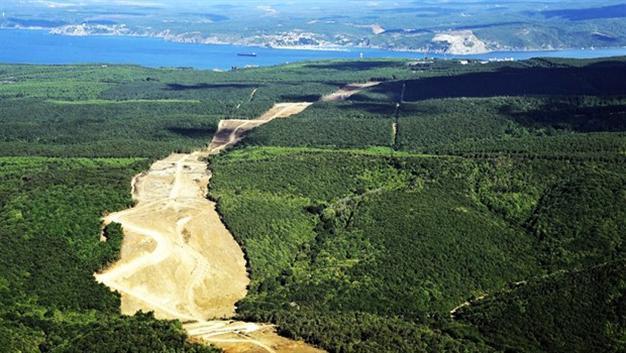Roads to Istanbul’s third bridge to cross first degree archeological sites
Serkan OCAK ISTANBUL - Radikal
 The Northern Marmara highway, which will be built to connect to Istanbul’s third bridge, will not only lead to the destruction of a huge forest area, but will also cross through eight archeological sites, according to two of Istanbul’s Cultural Heritage Protection Boards.
The Northern Marmara highway, which will be built to connect to Istanbul’s third bridge, will not only lead to the destruction of a huge forest area, but will also cross through eight archeological sites, according to two of Istanbul’s Cultural Heritage Protection Boards.Among those, five are considered “first degree archeological sites,” which means that it is legally compulsory to conduct thorough excavations prior to any construction, just like those carried out for the new Marmaray tunnel that crosses under the Bosphorus.
Experts say that the amount of time necessary for such archeological works would considerably delay the conclusion of the project, which is targeted to be completed by the end of next year.
According to Istanbul’s first Cultural Heritage Protection Board’s answer to a question submitted by a lawyer representing an environmental association, the eight archeological sites on the pathway of the third bridge’s roads are:
- A first degree archeological site including the İnceğiz caves and the Maltepe antic necropolis in the Çatalca and Silivri districts.
- The Anastasian Walls, also known as the long walls of Thrace in Silivri.
- The Kırkçeşme water tunnel in Gaziosmanpaşa and Sultangazi districts.
- The ancient city of Ispartakule-Spradon, considered as a first and third degree archeological site in Avcılar.
- Ancient tombs near the Şamlar village, located in the Arnavutköy district.
- Kartepe caves in Çatalca, considered as a first degree natural site and second degree archeological site.
- The Roman ruins of Philippi near the Sazlıbosna village in Arnavutköy, considered a first degree archeological site.
- A first degree archeological site neat the Küçükkılıçlı village in Silivri.

According to the board’s examinations of the project’s plans, the highway will also cross over the Anastasian walls and the Kırkçeşme water tunnel.
Lawyer Barış Yıldırım said construction was absolutely forbidden by law on natural and archeological sites, adding that restrictions were even more severe than with national parks.
“No activity that can alter the flora, topography or silhouette can be carried out on these sites. Not only is there an absolute prohibition on construction, but infrastructure services such as sewer systems, energy transportation lines, natural gas pipelines or drinkable water facilities can only be realized after the approval of the regional Cultural Heritage Protection Board. Even mentioning bridges and highways is out of the question,” Yıldırım said.
For its part, Istanbul’s first Cultural Heritage Protection Board said construction could take place, but should stop in the event that any archeological remains are unearthed.
The construction of Istanbul’s third bridge is continuing despite controversy, after a ruling for a stay of execution due to an unsatisfying environmental impact assessment report (ÇED) was recently overturned.
The new road will also connect to the third airport, which will be built on the city’s European side at the expense of a huge forested area.
















